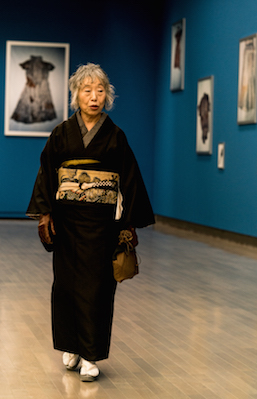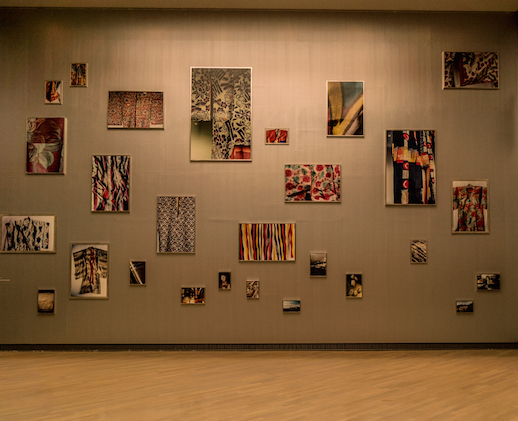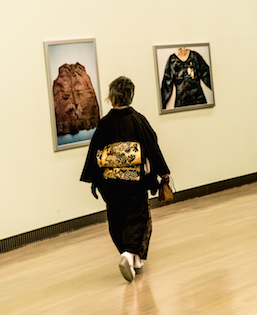Miyako Ishiuchi: Photo Weaver

“Kime to Shashin” – the title of the exposition in Japanese – is layered with multiple meanings, which seem key to understanding Ishiuchi’s work. Kime, or photographic grain, which is ever-so present in Ishiuchi’s images, can also refer to crops (like rice or wheat) or to a tiny amount of something (a grain of truth); but it can also be used to mean the texture of a material (stone or wood) or temperament.
Shashin is most often translated from the Japanese as “photograph.” But the word is actually much older than the technology that made it possible to imprint images on light-sensitive film or paper. In the most literal sense, shashin means “copy of the truth.” Ishiuchi has always found the physical aspect of photography – its chemical reactions – to be the most fascinating and important. She works exclusively with film and processes each of her prints by hand. She considers prints to be primarily physical objects and has a very visceral relationship with them. “I have always thought that the darkroom is such a sexual place,” she has said in interviews. “Its smell is so strong. And if you do it with bare hands, it’s like you’re having sex. Photography has that quality; it engages the five senses. It possesses something like sexuality.” In fact, it was darkroom work that inspired Ishiuchi to pick up photography in the first place.
Trained to dye silk (she studied weaving at the Tama Art University), Ishiuchi says she turned to photography after realizing that “the process of developing film miraculously fused the two subjects [… ] graphic design and textile dyeing.” She found photographic paper to feel much like fabric. “I print a photograph as if I am dyeing or weaving. The experience of thrilling to the images emerging through the developer, tracking the grains as though I could count each one, wound up becoming happy memories.”
Her early work is far from thrilling or happy, however. Ishiuchi debuted in 1977 with ‘Yokosuka Story’ – a series of dark and grainy images from the port city with a US military base. Ishiuchi’s parents moved there in the early 1950s, after she turned six. “Practically all of my memories are bad,” she remembers. “There were streets where girls were not allowed to walk, and rapes occurred daily but went unreported.”
“The natural choice is to photograph what you like. I chose what I hated,” she reflects on those early post-war years. Yet, returning to that painful and heavy past proved liberating. It allowed her to “cough up bad memories like black phlegm onto hundreds of stark white developing papers.”
Projects that followed – ‘Apartment’ (1977–78), in which she explored the interiors of Tokyo’s postwar housing, and ‘Endless Night’ (1978–80), for which she photographed brothels – were similar in nature: dark, depressing, roughly grained.

In the 1990s, Ishiuchi turned to intimate portraits of female bodies, focusing on scars, blemishes and wounds. In her own words, these are “proofs of lives lived.” The black and white images are still grainy – by now her signature technique – yet softer and quieter than previous works. Curators of the Yokohama exhibit present these works on pastel pink walls, further underscoring their delicate nature. Showing close-ups of wrinkles, calluses, burns and stains, Ishiuchi exposes vulnerabilities: what is usually hidden and not always easy to look at. Yet she does so with tremendous empathy, and as a result beauty rather than sadness pervades these photographs.
In 2000, following her mother’s death, Ishiuchi shifted focus to physical objects and started photographing in color. It was a way of dealing with her own personal wounds. As Ishiuchi recounts, for many years, her relationship with her mother was painfully difficult. Now confronted with loss and remorse, she was going through her mother’s most intimate possessions, not sure what to do. Did photographing old kimonos and underwear feel like touching someone she missed?
“I photograph things that are usually hidden. What appears on the surface doesn’t matter. I want the viewer to […] look underneath the undergarments and scars.”

Of course, as previously, Ishiuchi is interested in far more than objects: “Quietly concealed in the fold of a one-piece dress, once worn by a young girl from Hiroshima, I came across a patch of vivid color. In that moment, the girl from Hiroshima taught me that her dress embodies a history that can never become the past; an accumulation of time, steeped in the dye, that physically exists in parallel time with me,” she writes in an essay published in the exhibition catalogue.
“The girl’s body no longer exists but the memory of the fabric left behind soars up into the sky, enticed by the star of memory that may exist somewhere in the universe, composed of grains that once were Frida and my mother and all of the people who have died on this earth. I pray that a star of memory exists somewhere in the universe, as another form of eternity.”
Nobuyoshi Araki once called Ishiuchi a “photo weaver.” Indeed she weaves her images, exposing grains and mixing them with light, thrilling to them and fixing them on paper. Are these works “copies of truth,” or perhaps a search for it?
Magda Rittenhouse
Magda Rittenhouse


